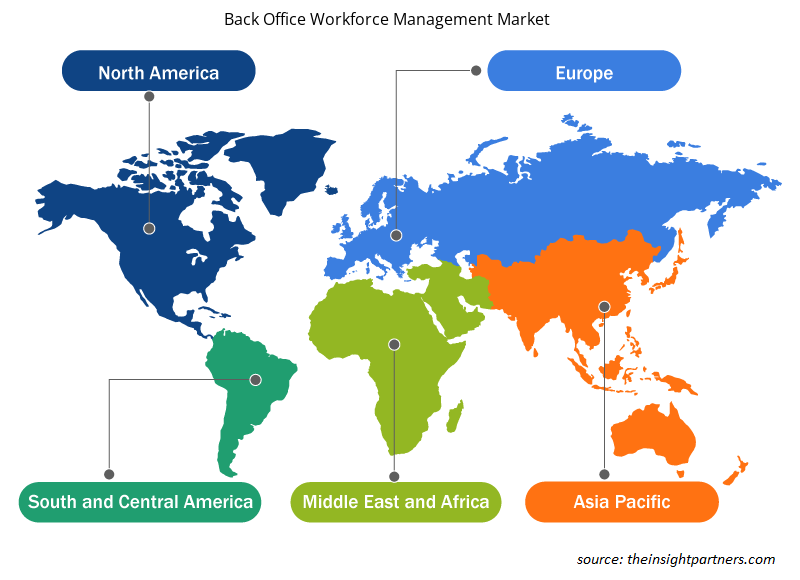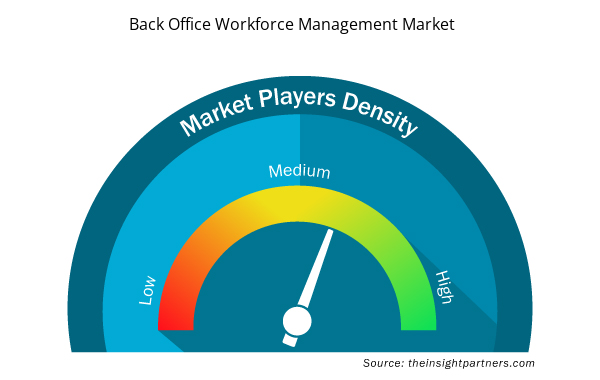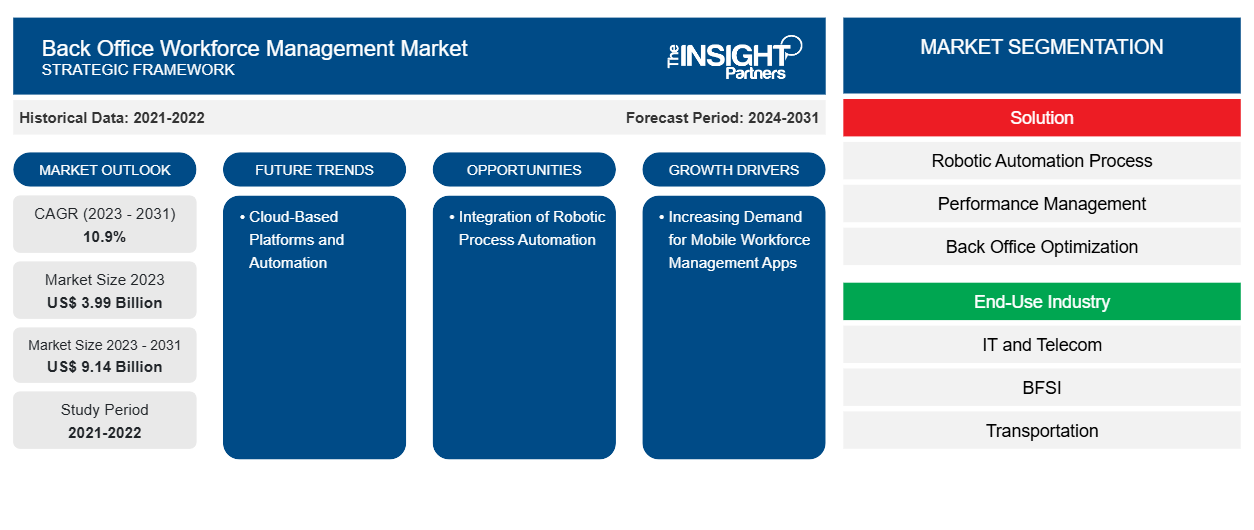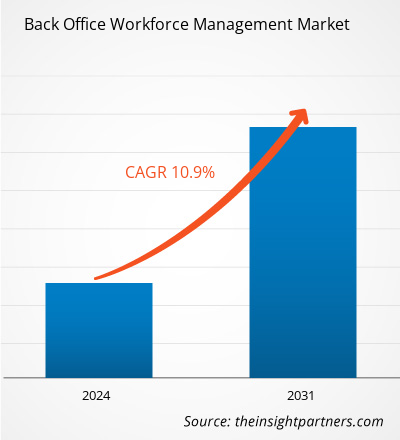Der Markt für Backoffice-Workforce-Management soll von 3,99 Milliarden US-Dollar im Jahr 2023 auf 9,14 Milliarden US-Dollar im Jahr 2031 anwachsen. Der Markt wird zwischen 2023 und 2031 voraussichtlich eine durchschnittliche jährliche Wachstumsrate von 10,9 % verzeichnen. Cloudbasierte Plattformen und Automatisierung werden voraussichtlich weiterhin ein wichtiger Trend auf dem Markt bleiben.
Marktanalyse für Back Office Workforce Management
Der Markt für Backoffice-Workforce-Management wird durch die Notwendigkeit der Personaloptimierung, die zunehmende Cloud-Bereitstellung und eine höhere Einhaltung verschiedener gesetzlicher Vorschriften angetrieben. Noch wichtiger ist, dass die Pandemie diesen Markt erheblich beeinflusst hat, indem sie die Einführung von Remote- und flexiblen Arbeitsvereinbarungen rasch beschleunigt und die Nachfrage nach Lösungen, die Remote-Arbeit ermöglichen, stark erhöht hat. Wichtige Marktteilnehmer und die Einführung transparenter , gerechtfertigter Mittel zur Mitarbeiterüberwachung wirken als wichtige Wachstumstreiber. Verbesserte Standards des Workforce-Managements durch die Integration neuer Technologien wie IoT und KI kurbeln den Markt ebenfalls an.
Marktübersicht für Back Office Workforce Management
Back Office Workforce Management bezieht sich auf die Verwaltung und Koordination interner Geschäftsabläufe, die nicht direkt mit Kunden in Verbindung stehen. Es umfasst umfangreiche Funktionen wie Buchhaltung, Bestandsverwaltung, Lieferkettenmanagement, Personalwesen, Logistik und IT-Dienste, um nur einige zu nennen. Das Back Office spielt eine wesentliche Rolle bei der Unterstützung der Ziele und Vorgaben des Front Office-Teams, indem es Aktivitäten im Zusammenhang mit Verwaltung, Datensatzpflege, Datenmanagement usw. übernimmt. Es kann außerdem eine effektive Verwaltung von Ressourcen, Technologien und Diensten umfassen, um einen ordnungsgemäßen Ablauf der internen Prozesse des Unternehmens sicherzustellen. Das Back Office ist wichtig für die Optimierung der Arbeitsbelastung, die Zufriedenheit von Kunden und Mitarbeitern und schließlich für die Verbesserung der Betriebsabläufe.
Passen Sie diesen Bericht Ihren Anforderungen an
Sie erhalten kostenlos individuelle Anpassungen an jedem Bericht, einschließlich Teilen dieses Berichts oder einer Analyse auf Länderebene, eines Excel-Datenpakets sowie tolle Angebote und Rabatte für Start-ups und Universitäten.
- Holen Sie sich die wichtigsten Markttrends aus diesem Bericht.Dieses KOSTENLOSE Beispiel umfasst eine Datenanalyse von Markttrends bis hin zu Schätzungen und Prognosen.
Markttreiber und Chancen für Back Office Workforce Management
Steigende Nachfrage nach mobilen Workforce-Management-Apps
Unternehmen suchen zunehmend nach anwendungsbasierten Lösungen zur Verwaltung der Backoffice-Belegschaft mit dem Ziel, intelligente Arbeitsumgebungen zu schaffen. Bedenken, die Vorteile der Mobilität zu nutzen, werden auf lange Sicht aufgrund der daraus resultierenden Ineffizienz hohe Kosten verursachen. In dieser Hinsicht kann eine mobile Anwendung verwendet werden, um eine einzige Plattform bereitzustellen, die im Mittelpunkt der Schaffung einer konsistenten Erfahrung für die gesamte vernetzte Mitarbeiterbasis steht. Durch die Standortüberwachung können Unternehmen relevante Inhalte und Echtzeitbenachrichtigungen an die gesamte Belegschaft liefern, um zeitnahe und relevante Erfahrungen zu schaffen, die Effizienz, Produktivität und Mitarbeiterengagement gewährleisten. Mobile Anwendungen erleichtern das manuelle Eintragen offizieller Arbeitstage und aller anderen Details in das Datensystem. Sie fungieren als ein Ort, über den alle digitalen Berührungspunkte, die an der Verwaltung einer Belegschaft beteiligt sind, nahtlos integriert werden können. Die Konsolidierung arbeitsbezogener Ressourcen in einer App ermöglicht es einem Unternehmen hingegen, die reibungslose Arbeit der Mitarbeiter innerhalb oder außerhalb des Arbeitsplatzes zu verwalten und auch mit den Managementteams und Mitarbeitern zu kommunizieren und zusammenzuarbeiten. Die zunehmende Anerkennung der Vorteile mobiler, app-basierter Lösungen für die Personalverwaltung schafft Chancen für Akteure auf dem Markt für die Personalverwaltung im Backoffice.touchpoints involved in the management of a workforce can be seamlessly integrated. Consolidation of work-related assets into one app, on the other hand, enables an enterprise to manage the smooth working of employees inside or outside the workplace and also communicate and collaborate with the management teams and coworkers. The growing level of
Integration von Robotic Process Automation
Einer der wichtigsten Trends, die der Markt wahrscheinlich erleben wird, ist die Einbindung der robotergestützten Prozessautomatisierung in Backoffice-Workforce-Management-Lösungen. RPA ist definiert als ein Mechanismus, der vorschlägt, eine größere Anzahl von Betriebsaufgaben durch Roboter zu übernehmen, was wiederum die Effizienz, Produktivität und das Engagement der Mitarbeiter erhöht. Die neue Welle der Nachfrage nach Automatisierung von Personalaufgaben ist eine hervorragende Gelegenheit für die Akteure dieser Branche. Sie kann genutzt werden, um ihre Fähigkeiten bei der Betreuung neuer Unternehmen zu steigern, die auf die Optimierung von Betriebsabläufen und Mitarbeiterleistung abzielen.RPA is defined as a mechanism that proposes to acquire a bigger number of operational duties by robots, which in turn increases efficiency, productivity, and employee engagement. The new wave of demand for automation of workforce responsibilities is an excellent opportunity for the players involved in this industry. It can be used to gear up its capabilities in catering to new businesses that look toward optimizing operational processes and employee performance.
Segmentierungsanalyse des Back Office Workforce Management-Marktberichts
Wichtige Segmente, die zur Ableitung der Marktanalyse für Backoffice-Workforce-Management beigetragen haben, sind die Lösungs- und Endverbrauchsbranche.
- Basierend auf der Lösung ist der Markt in Roboterautomatisierungsprozesse, Leistungsmanagement, Backoffice-Optimierung, Prozessanalyse und andere unterteilt. Das Segment Leistungsmanagement hatte im Jahr 2023 einen bedeutenden Marktanteil.
- Basierend auf der Endverbrauchsbranche ist der Markt in IT und Telekommunikation, BFSI, Transport, Einzelhandel und E-Commerce, Regierung und andere unterteilt. Das BFSI-Segment hielt im Jahr 2023 einen bedeutenden Marktanteil.BFSI, transportation, retail and e-commerce, government, and others. The BFSI segment held a significant market share in 2023.
Back Office Workforce Management Marktanteilsanalyse nach Geografie
Der geografische Umfang des Marktberichts zum Backoffice-Workforce-Management ist hauptsächlich in fünf Regionen unterteilt: Nordamerika, Asien-Pazifik, Europa, Naher Osten und Afrika sowie Süd- und Mittelamerika.
In Nordamerika sind die USA ein wichtiger Markt, da viele Fortune 500-Unternehmen ihren Hauptsitz in dem Land haben, was die Nachfrage nach Backoffice-Workforce-Management-Lösungen antreibt. Die Einführung cloudbasierter Workforce-Management-Lösungen nimmt zu, da immer mehr Remote-Arbeitsmodelle zum Einsatz kommen. So können Unternehmen die Arbeitszeiten und die Produktivität von Mitarbeitern, die an verschiedenen Standorten arbeiten, effektiv überwachen.
Regionale Einblicke in den Back Office Workforce Management-Markt
Die regionalen Trends und Faktoren, die den Markt für Back Office Workforce Management im Prognosezeitraum beeinflussen, wurden von den Analysten von Insight Partners ausführlich erläutert. In diesem Abschnitt werden auch die Marktsegmente und die Geografie des Back Office Workforce Management in Nordamerika, Europa, im asiatisch-pazifischen Raum, im Nahen Osten und Afrika sowie in Süd- und Mittelamerika erörtert.

- Erhalten Sie regionale Daten zum Back Office Workforce Management-Markt
Umfang des Marktberichts zum Back Office Workforce Management
| Berichtsattribut | Details |
|---|---|
| Marktgröße im Jahr 2023 | 3,99 Milliarden US-Dollar |
| Marktgröße bis 2031 | 9,14 Milliarden US-Dollar |
| Globale CAGR (2023 - 2031) | 10,9 % |
| Historische Daten | 2021-2022 |
| Prognosezeitraum | 2024–2031 |
| Abgedeckte Segmente | Nach Lösung
|
| Abgedeckte Regionen und Länder | Nordamerika
|
| Marktführer und wichtige Unternehmensprofile |
|
Marktteilnehmerdichte im Back Office Workforce Management: Die Auswirkungen auf die Geschäftsdynamik verstehen
Der Markt für Back Office Workforce Management wächst rasant, angetrieben durch die steigende Nachfrage der Endnutzer aufgrund von Faktoren wie sich entwickelnden Verbraucherpräferenzen, technologischen Fortschritten und einem größeren Bewusstsein für die Vorteile des Produkts. Mit steigender Nachfrage erweitern Unternehmen ihr Angebot, entwickeln Innovationen, um die Bedürfnisse der Verbraucher zu erfüllen, und nutzen neue Trends, was das Marktwachstum weiter ankurbelt.
Die Marktteilnehmerdichte bezieht sich auf die Verteilung der Firmen oder Unternehmen, die in einem bestimmten Markt oder einer bestimmten Branche tätig sind. Sie gibt an, wie viele Wettbewerber (Marktteilnehmer) in einem bestimmten Marktraum im Verhältnis zu seiner Größe oder seinem gesamten Marktwert präsent sind.
Die wichtigsten Unternehmen auf dem Markt für Backoffice-Workforce-Management sind:
- NICE GmbH
- Open Text Corporation
- Oracle Corporation
- Genesys
- Alvaria, Inc.
- Verint Systems, Inc.
Haftungsausschluss : Die oben aufgeführten Unternehmen sind nicht in einer bestimmten Reihenfolge aufgeführt.

- Überblick über die wichtigsten Akteure auf dem Markt für Back Office Workforce Management
Neuigkeiten und aktuelle Entwicklungen zum Back Office Workforce Management-Markt
Der Markt für Backoffice-Workforce-Management wird durch die Erhebung qualitativer und quantitativer Daten nach Primär- und Sekundärforschung bewertet, die wichtige Unternehmenspublikationen, Verbandsdaten und Datenbanken umfasst. Nachfolgend sind einige der Entwicklungen auf dem Markt für Backoffice-Workforce-Management aufgeführt:
- Zapier, die Workflow-Automatisierungsplattform für kleine und mittlere Unternehmen, gab bekannt, dass sie das Team hinter Vowel, einem KI-gestützten Videokonferenz-Tool, für einen nicht genannten Betrag übernommen hat. Vowels CEO Andrew Berman wird der neue Director of AI bei Zapier. Durch diese Übernahme wird sich das Vowel-Team auf die Verbesserung der KI-Automatisierungsfunktionen von Zapier konzentrieren.
(Quelle: Inter Zapier Inc., Unternehmenswebsite, März 2024)
Marktbericht zum Back Office Workforce Management – Abdeckung und Ergebnisse
Der Bericht „Marktgröße und Prognose für Back Office Workforce Management (2021–2031)“ bietet eine detaillierte Analyse des Marktes, die die folgenden Bereiche abdeckt:
- Marktgröße und Prognose für Backoffice-Workforce-Management auf globaler, regionaler und Länderebene für alle wichtigen Marktsegmente, die im Rahmen des Berichts abgedeckt sind
- Markttrends im Backoffice Workforce Management sowie Marktdynamiken wie Treiber, Einschränkungen und wichtige Chancen
- Detaillierte PEST/Porters Five Forces- und SWOT-Analyse
- Marktanalyse für Backoffice-Workforce-Management mit Blick auf wichtige Markttrends, globale und regionale Rahmenbedingungen, wichtige Akteure, Vorschriften und aktuelle Marktentwicklungen
- Branchenlandschaft und Wettbewerbsanalyse, einschließlich Marktkonzentration, Heatmap-Analyse, prominenten Akteuren und aktuellen Entwicklungen auf dem Markt für Backoffice-Workforce-Management
- Detaillierte Firmenprofile
- Historische Analyse (2 Jahre), Basisjahr, Prognose (7 Jahre) mit CAGR
- PEST- und SWOT-Analyse
- Marktgröße Wert/Volumen – Global, Regional, Land
- Branche und Wettbewerbsumfeld
- Excel-Datensatz


- GMP Cytokines Market
- Playout Solutions Market
- Queue Management System Market
- Vessel Monitoring System Market
- Skin Tightening Market
- Quantitative Structure-Activity Relationship (QSAR) Market
- Airport Runway FOD Detection Systems Market
- Military Rubber Tracks Market
- Vision Guided Robotics Software Market
- Sweet Potato Market

Report Coverage
Revenue forecast, Company Analysis, Industry landscape, Growth factors, and Trends

Segment Covered
This text is related
to segments covered.

Regional Scope
North America, Europe, Asia Pacific, Middle East & Africa, South & Central America

Country Scope
This text is related
to country scope.
Häufig gestellte Fragen
The market is projected to record a CAGR of 10.9% during 2023–2031.
The market is expected to reach a value of US$ 9.14 billion by 2031.
NICE Ltd., Open Text Corporation, Oracle Corporation, Genesys, Alvaria, Inc., Verint Systems, Inc., ActiveOps PLC, Calabrio Inc., Intradiem, and Team Software are key players in the market.
Cloud-based platforms and automation is a key trend in the market.
Increasing demand for mobile workforce management apps is driving the market.
Trends and growth analysis reports related to Technology, Media and Telecommunications : READ MORE..
The Insight Partners performs research in 4 major stages: Data Collection & Secondary Research, Primary Research, Data Analysis and Data Triangulation & Final Review.
- Data Collection and Secondary Research:
As a market research and consulting firm operating from a decade, we have published and advised several client across the globe. First step for any study will start with an assessment of currently available data and insights from existing reports. Further, historical and current market information is collected from Investor Presentations, Annual Reports, SEC Filings, etc., and other information related to company’s performance and market positioning are gathered from Paid Databases (Factiva, Hoovers, and Reuters) and various other publications available in public domain.
Several associations trade associates, technical forums, institutes, societies and organization are accessed to gain technical as well as market related insights through their publications such as research papers, blogs and press releases related to the studies are referred to get cues about the market. Further, white papers, journals, magazines, and other news articles published in last 3 years are scrutinized and analyzed to understand the current market trends.
- Primary Research:
The primarily interview analysis comprise of data obtained from industry participants interview and answers to survey questions gathered by in-house primary team.
For primary research, interviews are conducted with industry experts/CEOs/Marketing Managers/VPs/Subject Matter Experts from both demand and supply side to get a 360-degree view of the market. The primary team conducts several interviews based on the complexity of the markets to understand the various market trends and dynamics which makes research more credible and precise.
A typical research interview fulfils the following functions:
- Provides first-hand information on the market size, market trends, growth trends, competitive landscape, and outlook
- Validates and strengthens in-house secondary research findings
- Develops the analysis team’s expertise and market understanding
Primary research involves email interactions and telephone interviews for each market, category, segment, and sub-segment across geographies. The participants who typically take part in such a process include, but are not limited to:
- Industry participants: VPs, business development managers, market intelligence managers and national sales managers
- Outside experts: Valuation experts, research analysts and key opinion leaders specializing in the electronics and semiconductor industry.
Below is the breakup of our primary respondents by company, designation, and region:

Once we receive the confirmation from primary research sources or primary respondents, we finalize the base year market estimation and forecast the data as per the macroeconomic and microeconomic factors assessed during data collection.
- Data Analysis:
Once data is validated through both secondary as well as primary respondents, we finalize the market estimations by hypothesis formulation and factor analysis at regional and country level.
- Macro-Economic Factor Analysis:
We analyse macroeconomic indicators such the gross domestic product (GDP), increase in the demand for goods and services across industries, technological advancement, regional economic growth, governmental policies, the influence of COVID-19, PEST analysis, and other aspects. This analysis aids in setting benchmarks for various nations/regions and approximating market splits. Additionally, the general trend of the aforementioned components aid in determining the market's development possibilities.
- Country Level Data:
Various factors that are especially aligned to the country are taken into account to determine the market size for a certain area and country, including the presence of vendors, such as headquarters and offices, the country's GDP, demand patterns, and industry growth. To comprehend the market dynamics for the nation, a number of growth variables, inhibitors, application areas, and current market trends are researched. The aforementioned elements aid in determining the country's overall market's growth potential.
- Company Profile:
The “Table of Contents” is formulated by listing and analyzing more than 25 - 30 companies operating in the market ecosystem across geographies. However, we profile only 10 companies as a standard practice in our syndicate reports. These 10 companies comprise leading, emerging, and regional players. Nonetheless, our analysis is not restricted to the 10 listed companies, we also analyze other companies present in the market to develop a holistic view and understand the prevailing trends. The “Company Profiles” section in the report covers key facts, business description, products & services, financial information, SWOT analysis, and key developments. The financial information presented is extracted from the annual reports and official documents of the publicly listed companies. Upon collecting the information for the sections of respective companies, we verify them via various primary sources and then compile the data in respective company profiles. The company level information helps us in deriving the base number as well as in forecasting the market size.
- Developing Base Number:
Aggregation of sales statistics (2020-2022) and macro-economic factor, and other secondary and primary research insights are utilized to arrive at base number and related market shares for 2022. The data gaps are identified in this step and relevant market data is analyzed, collected from paid primary interviews or databases. On finalizing the base year market size, forecasts are developed on the basis of macro-economic, industry and market growth factors and company level analysis.
- Data Triangulation and Final Review:
The market findings and base year market size calculations are validated from supply as well as demand side. Demand side validations are based on macro-economic factor analysis and benchmarks for respective regions and countries. In case of supply side validations, revenues of major companies are estimated (in case not available) based on industry benchmark, approximate number of employees, product portfolio, and primary interviews revenues are gathered. Further revenue from target product/service segment is assessed to avoid overshooting of market statistics. In case of heavy deviations between supply and demand side values, all thes steps are repeated to achieve synchronization.
We follow an iterative model, wherein we share our research findings with Subject Matter Experts (SME’s) and Key Opinion Leaders (KOLs) until consensus view of the market is not formulated – this model negates any drastic deviation in the opinions of experts. Only validated and universally acceptable research findings are quoted in our reports.
We have important check points that we use to validate our research findings – which we call – data triangulation, where we validate the information, we generate from secondary sources with primary interviews and then we re-validate with our internal data bases and Subject matter experts. This comprehensive model enables us to deliver high quality, reliable data in shortest possible time.


 Holen Sie sich ein kostenloses Muster für diesen Bericht
Holen Sie sich ein kostenloses Muster für diesen Bericht